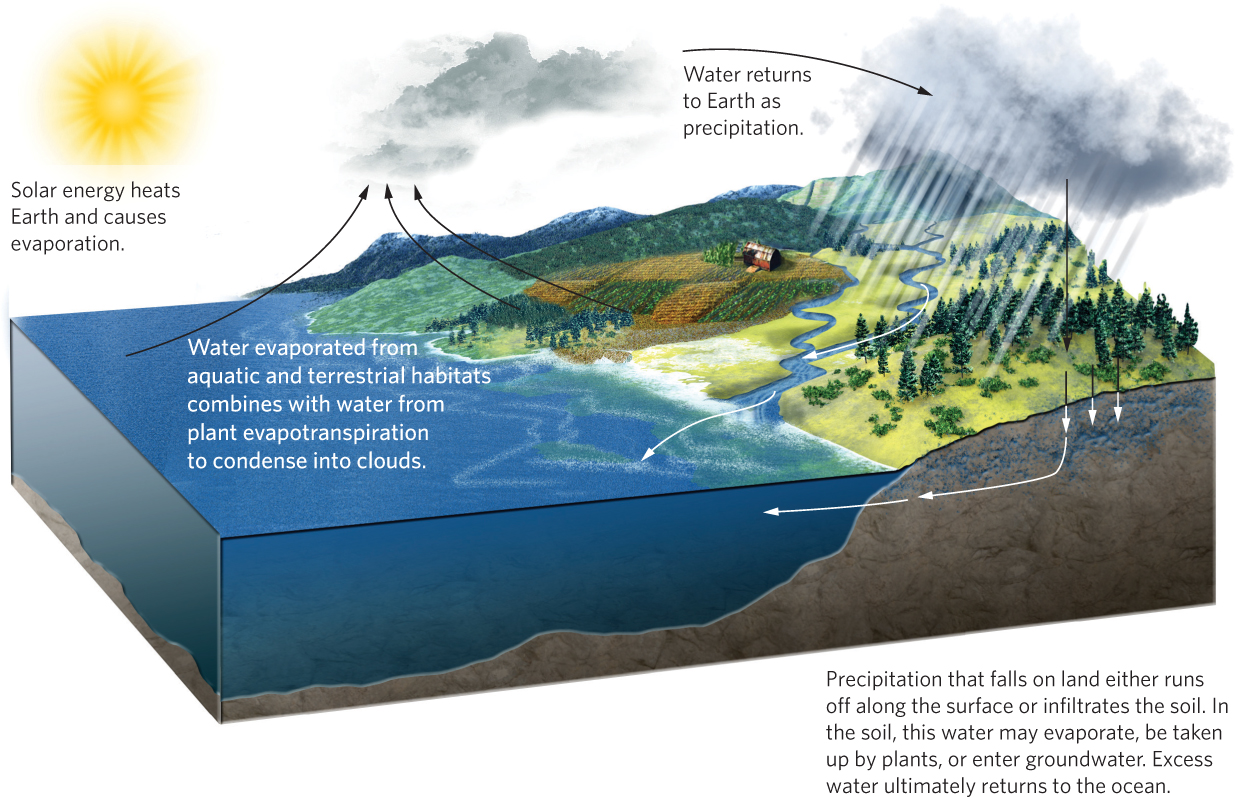The hydrologic cycle moves many elements through ecosystems
Throughout the previous chapter, we saw that water plays a critical role at every level of ecological study. In Chapter 2 we discussed how water is a key compound involved in the many chemical transformations that happen in the living and nonliving components of ecosystems. Chapter 5 examined the processes that determine global climates, including patterns of precipitation, and in Chapter 6 we discussed the various types of aquatic biomes. We begin this chapter by tracking the movement of water through ecosystems. Once we understand how water moves through ecosystems, we will look at the role water plays as it moves elements through ecosystems.
The Hydrologic Cycle
Hydrologic cycle The movement of water through ecosystems and atmosphere.
The movement of water through ecosystems and atmosphere, known as the hydrologic cycle, is driven largely by evaporation, transpiration, and precipitation. The largest pool of water, approximately 97 percent of all water on Earth, is found in the oceans. The remaining water exists in lakes, streams, rivers, wetlands, underground aquifers, and soil.
The hydrologic cycle is illustrated in Figure 21.1. Evaporation of water occurs from bodies of water, soil, and plants that experience evapotranspiration, which we discussed in Chapter 5. Solar energy provides the energy for the process of evaporation and evapotranspiration, which changes water from a liquid to a gas in the form of water vapor. There is a limit to the amount of water vapor that the atmosphere can contain. As additional water continues to evaporate, the water vapor in the atmosphere condenses into clouds that ultimately create precipitation in the form of rain, hail, sleet, or snow.

When precipitation drops from the atmosphere, it can take several paths. Some precipitation falls directly onto the surface of aquatic ecosystems and the rest falls onto terrestrial ecosystems. Water that falls onto terrestrial ecosystems can travel along the surface of the ground or it can infiltrate the ground where it is either absorbed by plants or moves deeper into the ground and becomes part of the underlying groundwater. The surface runoff and some of the groundwater will eventually find their way back into water bodies, thereby completing the cycle.
494
The amount of evaporation must balance the amount of precipitation or all of the water would continually accumulate in one part of the cycle. When we consider the hydrologic cycle on a global scale, we find that precipitation exceeds evaporation in terrestrial ecosystems, whereas evaporation exceeds precipitation in aquatic ecosystems. To help maintain an overall balance, the excess water that is evaporated from aquatic ecosystems is transported by the atmosphere and falls onto terrestrial ecosystems. At the same time, the excess water that falls on terrestrial ecosystems is transported in the form of runoff and groundwater into aquatic ecosystems.
Human Impacts on the Hydrologic Cycle
Water cycles through Earth’s biosphere with no net loss or gain over the long term. Therefore any change in one part of the water cycle influences the other parts. For example, in large developed areas, construction materials such as roofing and paved parking lots are impervious to water infiltration. The amount of water that can percolate into the soil is significantly reduced, and we see an increase in surface runoff. Less water is able to infiltrate the soil for plants to use or to replenish the groundwater that many people rely on for drinking water. An increase in surface runoff also increases soil erosion. A similar effect occurs when we reduce the amount of plant biomass in a terrestrial ecosystem, as occurs during logging. Where there are fewer trees and other plants, much less precipitation is taken up by plant roots and subsequently released to the atmosphere through evapotranspiration. Consequently, the amount of surface runoff increases, which often causes severe soil erosion and flooding (Figure 21.2). Finally, when we pump out groundwater for irrigation or household use, we sometimes reduce the amount of groundwater at a rate that exceeds its replenishment. For example, in the Great Plains of the United States, a large supply of groundwater, known as the Ogallala aquifer, extends from South Dakota to Texas. This groundwater supplies about 30 percent of all water used for irrigation in the United States and provides drinking water for 82 percent of the people who live in the region. However, the extraction of this water has exceeded its rate of replenishment and scientists are concerned that this critical supply of water for industry, households, and irrigation could run out sometime during this century.

Humans also alter the hydrologic cycle through activities that contribute to global warming. Scientists expect that as air and water temperatures rise, there will be an increase in the rate of water evaporation. An increase in the evaporation rate will cause water to move through the hydrologic cycle more quickly, potentially leading to an increased intensity of rain and snowstorms in various parts of the world.